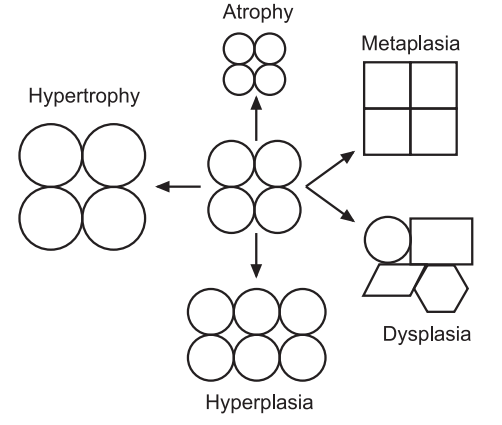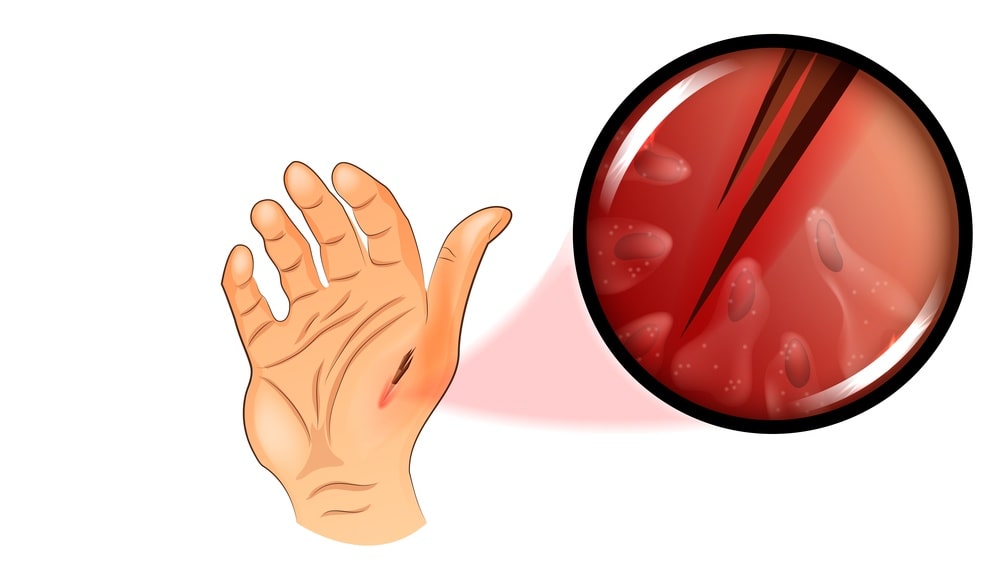Morphology of cell Injury and their adaptive changes
Table of Contents
Cell adaptation within limits
Most cells have the ability to adapt to changes in their environment by altering their morphology, pattern of growth, and metabolic activity. These adaptive responses may be part of the normal physiology of a cell or tissue, or they may represent an attempt to limit the harmful effects of pathological stress. Several basic patterns of macroscopic change have been described and are detailed below. It should be pointed out that physiologic signals such as hormonal stimuli can also cause tissues to change with similar patterns. Consequently, the adaptive mechanisms described below can be considered basic patterns of macroscopic change which can be induced by both pathological injury and in certain cases physiologic stimuli. Common examples include atrophy, hypertrophy, hyperplasia, metaplasia, and dysplasia.
Hypertrophy:
Hypertrophy refers to an increase in the physical size of cells. When hypertrophy occurs simultaneously in a population of adjacent cells this can lead to increased tissue or organ size. In certain clinical settings, the word “Hypertrophy” is loosely used in reference to any increase in tissue or organ size even if the increase is due to cellular Hyperplasia. Such conflation of hypertrophy and hyperplasia is difficult to avoid since in most cases hyperplasia and hypertrophy occur concurrently. The few cases in which an increased organ size occurs purely due to cellular hypertrophy (and includes no component of hyperplasia) are in the expansion of skeletal muscle and the myocardium whose cells cannot divide. In general, hypertrophy is due to increased functional demand on a tissue or due to specific hormonal stimulation.
Hyperplasia:
Hyperplasia refers to an increase in the number of cells within a tissue due to mitosis. It is important to note that hyperplastic cells still maintain strict regulatory control of their cell cycle. Consequently, when the stimuli which induce hyperplasia are removed, cells will terminate their divisions. In contrast, cell division in the absence of stimuli is considered as neoplasia. Hyperplasia can be induced by specific hormonal stimuli, increased functional demand on the tissue, or by injury to the tissue. Due to tissue injury, surviving cells often enter mitosis to replace those lost due to cell death. Use the search function for specific examples.
Atrophy:
Atrophy refers to a decrease in the physical size of cells. When atrophy occurs simultaneously in a population of adjacent cells this can lead to decreased tissue or organ size. In certain clinical settings, the word “Atrophy” is loosely used in reference to any decrease in tissue or organ size even if the decrease is due to the reduction in cell number. Such usage is difficult to avoid since in most cases reduction in cell size and number frequently occur together. Atrophy can occur due to reduced functional demand or reduced nervous or hormonal stimulation of the tissue. Long-term declines in blood supply can also lead to atrophic regression of perfused tissues.
Metaplasia:
Metaplasia refers to a reversible histological replacement of one differentiated cell type with another. Although by definition metaplasia is a reversible adaptation, it frequently precedes and may represent the initial steps of malignant transformation. Metaplasia is frequently induced by chronic cellular injury and represents an adaptation in which a tissue replaces a sensitive cell type with one better able to resist the injury.

Dysplasia:
The cells look abnormal under a microscope but are not cancer cells. Hyperplasia and dysplasia may or may not become cancer. Dysplasia refers to an abnormal and potentially reversible process where there is disordered growth and maturation of cells and tissues and organs. The number of adult and mature cells decreases while the number of immature cells increases. The microscopic changes which occur in reversible cell injury are cellular swelling (organelle changes) and fatty changes.
Make sure you also check our other amazing Article on: Cell Injury
